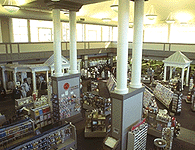
The spirit of excitement and creativity that characterizes the University these days is especially apparent in the construction underway across Grounds. Not since Jefferson's workmen laid foundations for the lawn has the University embarked on such an extensive and comprehensive building program.
In a few short years, as the brick facades mellow and newly planted trees mature, we will take these new additions for granted. Certainly, the students of the twenty-first century will have a difficult time imagining the University without the new Darden School complex or the expanded Law Grounds. But this year, as these projects take shape before our eyes, they stand as both a revelation of the University's strength and a confirmation of its commitment to the future. Projects underway or completed this year include:
- The Darden School Complex: This $40 million project on eleven acres derives its essential shape from the University's Central Grounds. It consists of an addition to Sponsors Hall, a classroom building, an administrative building, and a commons building with a library and study areas.
- The Law Grounds Project: A $25 million project to create a law school quadrangle by combining the current law school building and the former Darden School building.
- The Gilmer Field Recreation Facility: This building, scheduled for completion in 1996, will contain recreational administrative offices, an Olympic-sized pool, and major weight and fitness facilities.
- Jordan Hall Addition: This project adds seven floors of faculty and research space and a conference center to Jordan Hall. It opened in September 1995.
- Bryan Hall: The English Department occupied its new home during Spring Break. Named in honor of John Stewart Bryan, a prominent alumnus and former University rector, the building provides eighty-three faculty offices, seven classrooms, a computer laboratory, and five staff rooms.
- The Ivy Stacks: This new climate-controlled library storage facility houses 1.2 million less-used volumes that can be retrieved on demand in just twenty-four hours.
- Chemistry Building Addition: The addition to the chemistry building includes twenty -seven major laboratories. It opened in June 1995.
In keeping with its policy of making better use of existing facilities, the University has embarked on its plan to renovate the Old Hospital, creating new space for laboratories and private clinics.

|

|
| The University Bookstore and Central Grounds Parking Garage. The 45,000-square-foot bookstore opened in late 1994. |
|
Preserving Our Architectural Heritage
No matter how impressive each of these new buildings and building complexes is in its own right, they all pay homage to Jefferson's academical village, the University's historic heart. The Lawn's importance was highlighted when it was named one of sixty-three Great American Public Places in the United States following a yearlong examination of nearly two hundred candidates by a panel of experts. It will be included in the 1995 Pocket Guide to Great American Public Places, a handbook for builders and developers who hope to foster a more civil society through architecture and planning.

Over the last decade, the University has carried out an extensive program to preserve and restore its Jeffersonian past. This year the University of Virginia was chosen to receive the Institute Honor Award from the American Institute of Architects for this effort. The program was "recognized as a role model for institutions with historic buildings complexes," the citation said. "The school's leadership has taken an intelligent and com prehensive approach to achieve this restoration, doing the research, selecting highly qualified professionals, securing adequate funding, and even using the restoration process as a teaching tool."
This example is pertinent as we face design challenges imposed by our growing population and our finite natural resources. To encourage development that sustains the environment, the Class of 1995 pledged $150,000 to support construction of a Solar Energy Research Center at the Architecture School and to underwrite fellowships for students doing work in this field.
